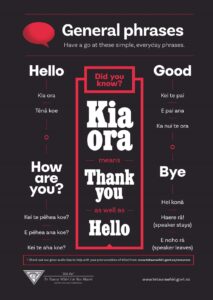From the greetings when you first touch down (‘kia ora’ or ‘hello’) to place names such as Aotearoa (‘Land of the long white cloud’ a.k.a. New Zealand) to a national anthem sung in two languages, Te Reo Māori (the Māori language) is a part of everyday life in New Zealand.
It is not as widely spoken as English, but Te Reo is one of NZ’s official languages and it’s well worth learning a few words and phrases when you visit. Māori culture is an integral part of New Zealand’s identity and history, and you will see and hear that influence throughout the country when you visit.
This guide will not make you a Te Reo expert, but it will introduce you to the basics so you know your ‘kia ora’ from your ‘ka pai’ and ‘kai moana.’
Without getting too complex, Te Reo is largely a phonetic language, meaning what you see is what you say and hear. This is because it wasn’t a written language until the arrival of Europeans, who then began writing based on what they heard.
The biggest difference for English speakers is the use of ‘ng’ and ‘wh’, which are used as consonants.
- ‘Ng’ is pronounced like in the word ‘singer’ and tends to have a nasal sound to non-Māori speakers.
- ‘Wh’ is pronounced as a soft ‘f’ sound. Visitors tend to get a chuckle when they realise how to correctly pronounce words like ‘whakapapa’ as it sounds very naughty in English.
When saying words, syllables are formed by pronouncing vowels on their own or a consonant followed by a vowel.
For example: Aotearoa = a-o-te-a-ro-a
Key words and phrases:
Greetings & Goodbyes
Kia ora (key-or-a) – Hello, goodbye, thank you
Haere mai (high-reh-my) – Welcome
Mōrena (more-en-a)- Good morning
Haere rā (high-reh-rah) – Goodbye, farewell
Ka kite anō (Kah-key-te-ah-no) — Until I see you again (goodbye to one person); incorrect phrase, but commonly used – the full correct phrase is Ka kite anō au i a koe
People
Iwi (Eee-wee) – Tribe
Whānau (far-no) – Family, including extended family and those considered close
Wāhine (wa-he-ney) – Woman
Tāne (ta-ney) – Man
Pākehā (pa-key-ha) – Europeans
Other Things You’re Likely to Hear
Marae (ma-rye) – Courtyard in front of a meeting house, but often includes the surrounding buildings too
Haka (ha-kah) – war dance or ceremonial dance
Hāngi (hung-ee) – Feast
Waka (wah-kah) – canoe
Kai (kai) – Food
Kai moana (kai moe-ahn-ah) – Seafood
Mana (ma-nah) – Honour, respect, authority
Tapu (ta-poo) – Sacred, has spiritual significance, taboo
Aroha (ah-row-ha) – Love
Ka Pai! (kah pai)- Good, well done
Hui (who-eee) – meeting or gathering
Koha (ko-hah) – gift, donation
Disclaimer: This is a quick reference guide for foreign visitors. Te Reo is a beautiful and fascinating language that is impossible to fully cover in a quick-read article. We encourage everyone who’s keen to learn more!

